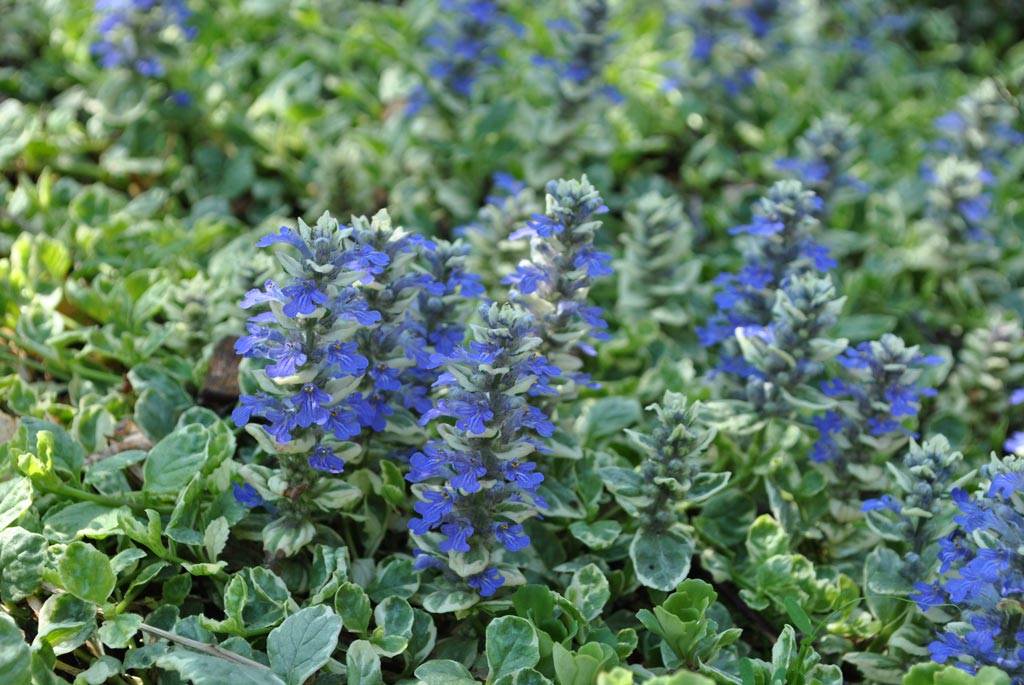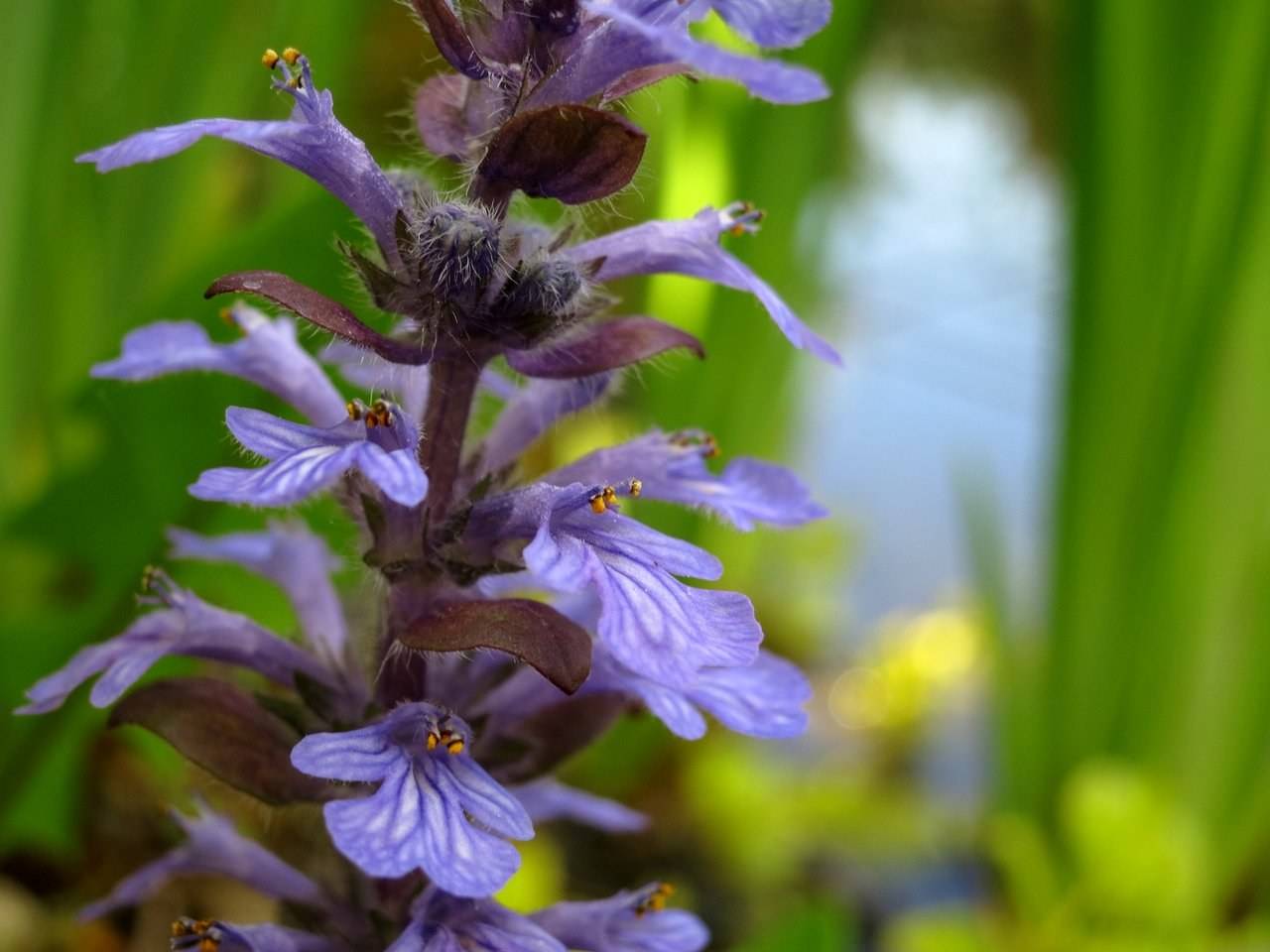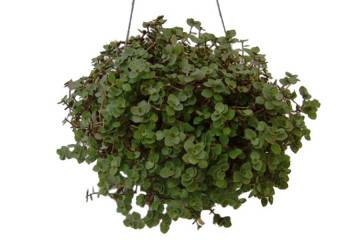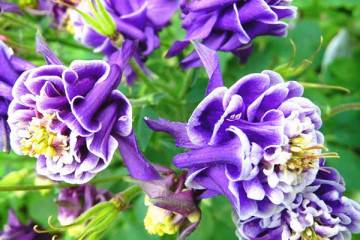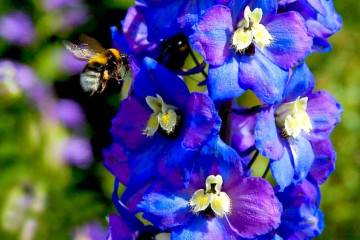Creeping insect (Ajuga Reptans) - planting and growing from seeds
Content:
The tenacious creeping has several names among the people - non-withered, non-withered, oak, Dubrovka. It is she who immediately after winter decorates the flower beds, since her foliage remains practically alive. As soon as all the snow melts, the tenacious bloom. What kind of plant is a creeping tenacious?
What does a creeping tenacious look like, which family it belongs to
Tenacious creeping or Ayuga (Ajuga Reptans) is a ground cover primrose, a creeping perennial herb of the Labiate or Lamb family.
The tenacious animal has the ability to survive in light frosts, gives a large number of side shoots. The thin stems are like strawberry whiskers. It has several apical rosettes, with which it easily clings to the ground cover layer, thereby multiplying. Over time, the tenacious fills large spaces on the soil, which makes it seem like a carpet.
The root system is fibrous. Leaves are light green, ovate-lanceolate, with a carved or even edge.
Tenacious is widespread in all countries. Perhaps, it does not grow only at the North Pole. A lover of wet meadows, forests can easily tolerate arid places, rocky slopes, hills.
The plant is appreciated by gardeners for its ground cover ability, thanks to which it is used in landscape design for decorating alpine slides. In addition, the flower is actively used by traditional healers. Ayuga possesses:
- bactericidal property;
- anti-inflammatory;
- hemostatic and hematopoietic;
- diuretic and diaphoretic;
- antiseptic and wound healing.
Due to these features of the chemical composition, the tenaciousness helps with some diseases:
- pulmonary tuberculosis;
- bloody diarrhea;
- inflammation of the uterus;
- stomach ulcer;
- colds and flu;
- bronchitis.
The plant can be used externally for rinsing with angina, wraps for burns and frostbite, for cosmetic purposes for the skin and hair, for purulent wounds.
What types of Ajuga grow in nature
Science knows 45 species of the tenacious plant. The species set is distinguished by the color of leaves and inflorescences. The most common varieties breeders have worked on are:
- Geneva. This plant has no creeping shoots. Stem 30-50 cm high, abundantly pubescent. The color of the flowers is blue and blue, but there are also pink shades. This species is represented by Helena and Blue Sea varieties. The tenacious Geneva variety Helena is the tallest flowering plant (50 cm) with lilac flowers. The Blue Sea is a low representative of the Geneva tenacious, reaching only 20 cm in height. This plant has blue flowers. The leaves of both varieties have abundant pubescence and brightly marked flower stipules.
- Chios. A small bush of the Chios tenacious has three stems, branched at the base. The leaf plate is small and thin, slightly covered with a dark green fluff.A distinctive feature of the Chios variety is the presence of yellow flowers, the lower petals of which are much larger than the upper ones. It is the Chios tenaciousness that is the favorite of gardeners, as it blooms from early spring to late autumn. The plant is drought-resistant, so it will perfectly decorate any slope or rocky hill.
- Pyramidal. Its distribution area is European countries. The pyramidal tenacious grows very slowly and apart, not filling the soil around it. It tolerates drought well, making it feel good on rocky slopes. The leaf plates are covered with thick hairs that are pleasant to the touch. Pyramidal Ayuga does not grow higher than 25 cm, its peduncles are also low, up to 10 cm. The species got its name because of the bizarre structure of the upper part of the plant, which resembles the shape of a regular pyramid. The most common variety is the Metallica crisp.
- The hairy tenacious (Ajuga genevensis) is a type of the Geneva Ayuga. Its feature is the abundant pubescence not only of the stems, but also of the leaves and bracts. This plant is most often used for the preparation of medicinal drugs.
- Eastern (Ajuga orientalis) is a dwarf tenacious herb, reaching a height of no more than 12 cm. It blooms with purple flowers.
- Laxman - a species of tenacious plant is distinguished by its ability to grow upwards, and not to the sides. Bushes are up to half a meter. Shoots and leaves are densely pubescent and have a silvery color. Against the background of beautiful large foliage, the flowers seem inconspicuous, and their color is pale pink or pale yellow.
- The herringbone Ayuga tenacious is an annual, one can call a grass, since it grows no more than 6 cm. The leaves are small, cone-shaped, have a grayish color. The species is named due to the presence of a coniferous smell. The flowers are small, yellow. The species is attractive for its long flowering, lasting from May to October.
- Turkestan (Ájuga turkestánica). The species is named precisely for the growing area - the foothills of Tajikistan and Uzbekistan. A perennial low-branched shrub up to 50 cm in height has thickened stems, which significantly differs from its relatives. The growth has a reddish tint, at the ends it is painted in more saturated colors. The leaves are located only on the top of the shoots, mainly brown in color. Small pink or purple flowers.
Description of varieties Ajuga reptans
The most, perhaps, the most common and sought-after by landscape designers and gardeners are those that have some sophistication. These include:
- The tenacious Burgundy Glow variety attracts with the color of the foliage, which is purple, more often bright purple. A beige border is clearly visible along the edges of the leaves, and shapeless pinkish spots closer to the base. If the plant is kept in partial shade, the color becomes more intense.
- The tenacious Black Skellop variety is considered dwarf, since it rarely grows to 10 cm.The leaves are beet-colored, which plays with purple tints in the sun. The edges of the foliage are carved, which distinguishes the variety from others.
- Arctic Snow is a variegated tenacious variety, bred later than the rest. The foliage is large (10 cm long), has a corrugated structure. The base of each leaf is dark green, only along the edges and in the center there are ashy strokes.
- Chocolite Chip is a funny miniature plant up to 5 cm high. The leaves are slightly oblong, have bright purple strokes on a dark green background. In sunlight, the colors merge and appear shiny. The variety wins due to its ability to grow in the shade, which is why the color saturation is not lost.
- Multicolor is the most popular variety of creeping hardy. The foliage of the plant contains all the colors that the tenacious has: dark green, purple, purple, ash, cream and pink. The intensity of each of them depends on the location of the flower.
- The tenacious Atropurpurea variety is a ground cover plant with large leaves that reach 17 cm in length and have the shape of an egg. Attention is attracted more by basal leaves than near-stem leaves, the color of which is bronze-green.
- Mahogany is a variety of primrose with large dark green leaves that appear bluish-black in the shade. Used to decorate garden paths, as the variety can grow in any conditions.
Complement the list of varieties:
- Lunar Landing, Crispa - pyramidal;
- Sparkler, Variegata, Rainbow, Polar fox, Rosea - creeping.
Each variety is unique in its own way. Some adorn the flower bed due to the fluffy and colorful foliage, while others delight the eye with unusual colors of flowers.
Features of caring for a tenacious creeping house
It is worth noting that planting and caring for the creeping tenacious is not difficult. It is enough to carry out a number of agrotechnical measures.
During the spring awakening and after the snow melts, the tenacious requires abundant watering, despite the presence of moisture in the soil. As soon as young offspring and leaves begin to appear, the amount of water is reduced and watered only in dry times once a week.
By the middle of summer, the ground cover forms beautiful lawns from densely accreted shoots, thereby reducing the evaporation of moisture from the soil. But the top irrigation is still required. Sprayed in the morning and evening hours.
You can plant a tenacious animal anywhere. The presence of sunlight or lack thereof is not a hindrance to plant growth. But nevertheless, the tenacity makes some demands on the ground. Prefers light fertile loams with high humidity, but if there is not enough moisture, then there are no problems with growth, it is enough to irrigate the flower beds several times a week.
The tenacious is able to survive even on the poorest soils. To maintain its decorative appearance, it is necessary to feed the plant 1-2 times a month. It is enough to add any complex of minerals or organic matter in the form of rotted manure, chicken droppings, ash, compost.
Features of winter care
The tenacious lives up to its name. She perfectly tolerates even the most severe winters, but with extensive growth. It is better to cover newly planted bushes with coniferous spruce branches, plant tops or covering material.
When and how it blooms
The tenacious flower has the following structure:
- inflorescence - ear;
- type of flowers - two-lipped;
- location - in the axils of the leaves, collected in 6-8 pieces;
- cup length - 7 mm;
- corolla shape - bell-shaped;
- upper petals - short two-lobed lip;
- lower petals - long three-lobed lip;
- rim length - up to 17 mm;
- completely pubescent outside;
- coloration: blue, light blue, shades of violet, pink, cream, yellow.
After flowering, the petals do not fall off, but remain with the fruits, but already in a dried form.
The flowers of the tenacious are not decorative, therefore, no special care is required during flowering.Some gardeners deliberately cut off the flower stalks to make the carpet look more elegant, and cutting off the inflorescences is required during the ripening of the seed boxes so that the tenacious does not thicken and outlive itself.
Vegetative propagation
The most common breeding option for a tenacious is vegetative. Separation of daughter outlets is started in spring or autumn, before the onset of constant frosts. The rosettes are carefully cut from the mustache and transplanted to a new location.
Each outlet is planted individually or in a group design so that the next year the flowerbed looks like a carpet. Immediately after planting, young seedlings are well watered, and the soil around is compacted. They must be covered for the winter.
Seed planting
At home, the tenacious is propagated vegetatively, by separating outlets. The seed method is mainly applicable in breeding for breeding varieties. In your own garden, you can still grow a flower from seeds if it was not there before, but they must be purchased. Shop seeds have a better germination rate than hand-picked seeds.
The peculiarity of seed cultivation in the open field is that the varietal characteristics of the mother plant will not be preserved in the future with self-collection of planting material. A newly grown plant will resemble a wild plant with no foliage color palette.
Sowing is started in the spring, after the soil has completely warmed up, or in late autumn. The trunk circles of fruit trees are chosen as a place. Under them, the seeds will be well preserved until next year and will not die from severe frosts.
Purchased tenacious seeds do not require treatment with growth stimulants. They are directly sown in prepared beds. If the soil on the bed is depleted, then sand, peat and rotted manure should be added in equal proportions.
The basic rules that should be followed when sowing:
- Embedding depth - 2-3 cm.
- The distance between adjacent achenes is 8-10 cm.
- The distance between adjacent rows is 10-15 cm.
After the emergence of seedlings, the condition of the beds is carefully monitored. Weed in time so that the weeds do not pull nutrients. As the soil dries, the beds are watered, and in dry weather they are additionally irrigated in the morning and evening. For the winter, they must be covered, since young sprouts die.
Transfer
In one place, Zhyvuchka should grow no more than five years. After that, it should be updated by transplanting new rosettes or rhizome divisions. The aerial roots of the stem are small, so it is enough to sprinkle them with soil in a new place. Further care consists in regular watering and removing weeds.
Possible problems when growing a creeping tenacious
The tenacious is unpretentious and does not take up a lot of physical strength. But nobody canceled diseases and pests.
Diseases
When growing a cultivated ground cover, they monitor the humidity, since with an excess of the tenacious, the roots die off, and the decorative foliage is lost. To protect the plant from root rot, place the flower bed away from the place where water stagnates in spring. It has a detrimental effect on the flower.
Pests
The tenacious has an unusual chemical composition, thanks to which it is able to independently "sew off" small insect pests, but it cannot escape from slugs. It is the juicy leaves that attract gastropods. To drive away uninvited guests from the garden, small bumps of stones are poured around the perimeter, through which it is difficult for slugs to crawl.
Tenacious is a beautiful ground cover flowering plant that does not take a lot of time and effort from the gardener. The main thing is to carry out all the manipulations on time so as not to let the lawn thicken.After completing simple maintenance operations, after a few months you can get a colorful carpet in the flower bed.



